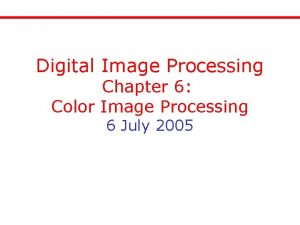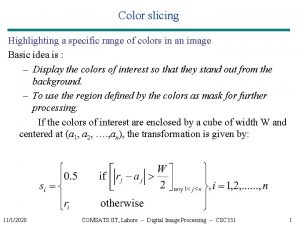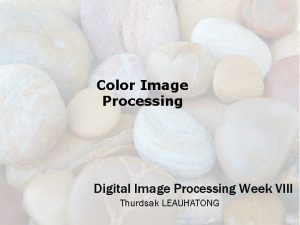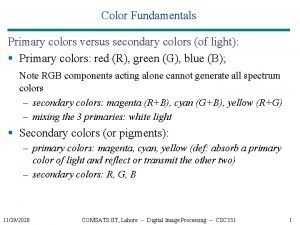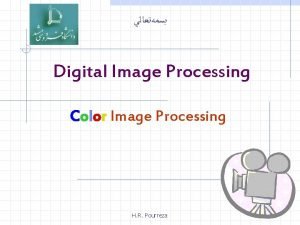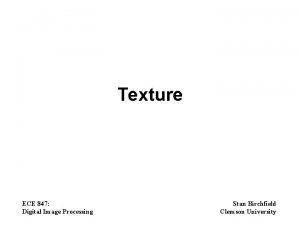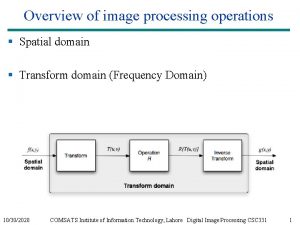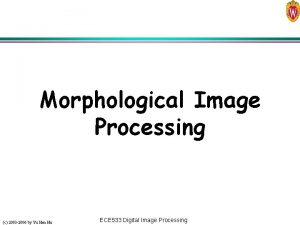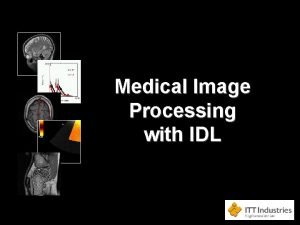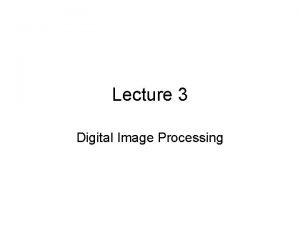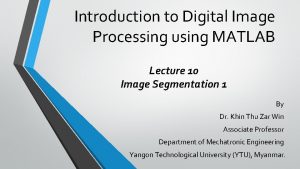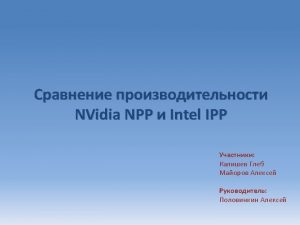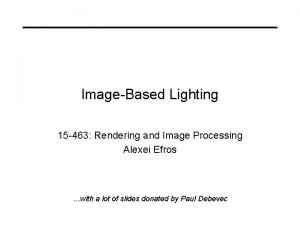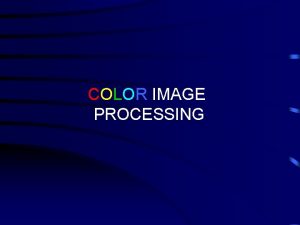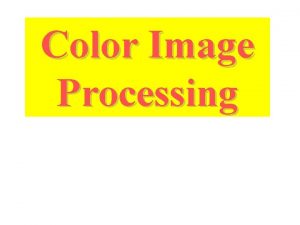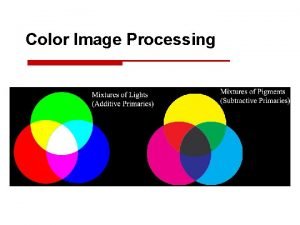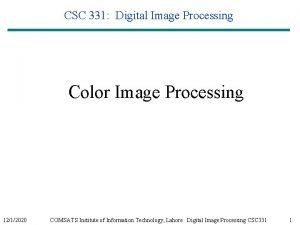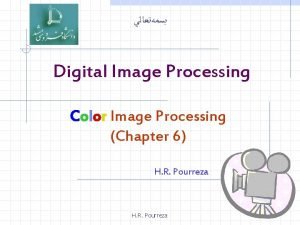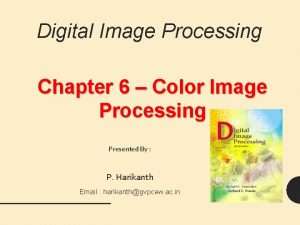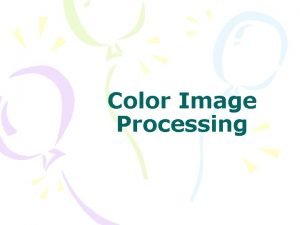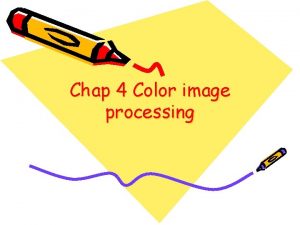6 COLOR IMAGE PROCESSING 1 Why color image





























![INTENSITY SLICING • Let [0 – L-1] gray scale. This scale is divided into INTENSITY SLICING • Let [0 – L-1] gray scale. This scale is divided into](https://slidetodoc.com/presentation_image_h2/981140808167ad4517d557e48c545e26/image-30.jpg)







![COLOR TRANSFORMATIONS • g (x, y) = T [f (x, y)] • T is COLOR TRANSFORMATIONS • g (x, y) = T [f (x, y)] • T is](https://slidetodoc.com/presentation_image_h2/981140808167ad4517d557e48c545e26/image-38.jpg)






- Slides: 44

6. COLOR IMAGE PROCESSING 1

Why color image processing? • Color simplifies object identification and extraction from scene. • Thousands of color shades can be discerned by human eye whereas only few gray levels shades can be discerned. 2

Categories of Color Image Processing Ø Full Color Processing : - Images acquired with full color sensor like color TV , camera or color scanner. Ø Pseudo color Processing: - Assign color to particular monochrome intensity or range of intensities. 3

Color Fundamentals • Sir Isaac Newton discovered that white light when passes through prism, breaks into seven colors VIBGYOR while each color smoothly blends into other. • Color is perceived as the wavelength reflected back from object. • When the object reflects all seven colors in equal proportion it appears white. • When an object reflects wavelength corresponding to green color and absorbs all other wavelengths it will appear green. • When an object does not reflect at all i. e. absorbs all wavelengths it appears black. 4

Color Spectrum 5

Electromagnetic Spectrum 6

Attributes of Light Ø Monochromatic Light: - Only one attribute which is intensity. Ø Color Light: - Three attributes: Radiance, Luminance and Brightness 7

Primary and Secondary Colors • In human eye cones and sensors are responsible for color vision. • There are 6 to 7 million cones in human eye which can be divided into 3 categories red, green and blue. • 65% are sensitive to red • 35% are sensitive to green • 2% are sensitive to blue. • Due to these absorption characteristics colors are seen as combinations of 3 primary colors i. e. RED, BLUE, GREEN. 8

• No single color can be called as RED, BLUE or GREEN since colors blend with each other. Therefore, for Standardization CIE designated 3 primary colors the following frequencies. • • Blue = 435. 8 nm Green= 546. 1 nm Red = 700 nm Primary colors add to form secondary colors. Magenta = Red + Blue Cyan = Green + Blue Yellow = Red + Green 9

10

Characteristics of Color • Hue : - Dominant wavelength in mixture of light waves. Dominant color perceived by observer. • Saturation: - Relative purity or amount of white light mixed with hue. • Brightness: - chromatic notion of intensity. Pure spectrum colors are fully saturated. Colors such as pink (Red + white), lavender (violet + white) are less saturated. CHROMATICITY: - Hue and saturation taken together. 11

TRISMULUS VALUES • Amount of red, blue or green needed to form a color are called trismulus values represented by X, Y, Z respectively. The color is defined as: x= X/ X+Y+Z y= Y/X+Y+Z z= Z/X+Y+Z x +y +z=1 X: - amount of red required for color Y: - amount of green required for color Z: - amount of blue required for color. 12

CIE Chromaticity Diagram • The various colors VIBGYOR are around tongue shape chromaticity diagram. • These are pure colors. • Other points in diagram represents mixture of colors. • All points on boundaries are fully saturated. • As point leaves boundary and approaches point of equal energy, it becomes less saturated. • Saturation at point of equal energy (WHITE) is zero. • Straight line joining any two colors on the chromaticity diagram represents colors which can be formed by mixing two colors. 13

COLORS MIXED USING RED AND GREEN RED WHITE ALL SHADES OF RED 14

CIE Chromaticity Diagram 15

COLOR MODELS • Color is specification of co-ordinate system and a subspace within that system where each color is represented by single point. 16

RGB Color Model • • • Model based on Cartesian co-ordinate system. Color space is a cube. RGB are 3 corners of cube. Black is at origin. White is at corner farthest from origin. Line joining 2 points form gray scale. Different colors are points on or inside the cube. Cube is unit cube. Value of R, G, B are in the range [0, 1]. 17

RGB Color Model 18

Pixel Depth: - Number of bits used to represent each pixel in RGB space is called pixel depth. If depth = 24 bits , each image plane is of 8 bits. Such type of image is called full color image. Total number of colors in 24 -bit RGB image is (28)3 = 16, 777, 216 All systems safe colors: - Subset of colors that can be produced by any system. 256 is the safe colors for any system. 19

20

21

CMY AND CMYK color models • • • CMY : - Cyan , Magenta , Yellow color model Many color printers and copiers require this model. [C, M, Y] = [1 1 1] – [R, G, B] Therefore, pure cyan does not reflect red Pure magenta does not reflect green Pure yellow does not reflect blue. Similarly, [R, G, B] = [1 1 1] – [C, M, Y] Combining CMY produces muddy looking black. To produce pure black, fourth pure black color is added. So model known as CMYK where K is black. The printing techniques using these four colors is known as four color printing. 22

HSI COLOR MODEL (Hue , Saturation and Intensity) • RGB and CMY describes color by giving its composite colors. But this is not practical method for human interpretation. • When humans view a color object, they describe by its hue, saturation and brightness. 23

Obtaining HSI from RGB • Intensity: - Take the RGB cube and stand it on the black (0, 0, 0) vertex with (1, 1, 1) white directly above it. • Intensity is along line joining these vertices. • To find intensity component of any color, pass a plane perpendicular to intensity axis containing the color point. • Saturation: -Saturation of color increase as we move away from intensity axis. • Saturation point at intensity axis is 0 by the fact that all points are gray. 24

• Hue: - Form plane take 3 points : Black, white and a color. • All points in the plane segment and points on boundaries of cube have the same hue. • By rotating the plane on vertical axis, different hues are obtained. 25

CONVERSION AMONG DIFFERENT COLOR MODELS • • • Ø Ø Ø RGB to HSI Assumed that RGB values have been normalized to [0, 1] and angle θ is measured with respect to red axis of HSI space. Conversion equations HSI to RGB RG sector (0° <= H <= 120°) GB sector (120° <= H <= 240°) BR sector (240° <= H <= 360°) 26

Relation between RGB and HSI Model 27

28

PSEUDOCOLOR IMAGE PROCESSING Ø Assigning colors to gray level values based on certain criteria. Ø Major use is interpretation of gray level images. Ø Two techniques are used: ü Intensity slicing ü Gray level to color transformations 29
![INTENSITY SLICING Let 0 L1 gray scale This scale is divided into INTENSITY SLICING • Let [0 – L-1] gray scale. This scale is divided into](https://slidetodoc.com/presentation_image_h2/981140808167ad4517d557e48c545e26/image-30.jpg)
INTENSITY SLICING • Let [0 – L-1] gray scale. This scale is divided into L levels where l 0 represents black f (x, y) =0 and level l. L-1 represents white f (x, y) = L-1. Total P planes are defined perpendicular to intensity axis defined at levels l 1, l 2, …, lp and 0 <P< L-1. • P planes partition gray scale into P+1 intervals V 1, V 2, …, V p+1 • Gray to color assignments are made as f (x, y) = ck if f (x, y) ε Vk Vk : - interval formed by partitioning planes at l = k-1 and l=k ck : - color associated with kth intensity interval Vk. 30

• Any plane slice the image function into two levels. • Different color is assigned to each plane. Any pixel whose gray level is above the plane will be coded with one color and below the plane will be coded with other. • Pixels on the plane can be assigned any color. • Result is two color image. • When more colors are used, mapping function takes staircase form. 31

Intensity Slicing 32

33

Gray level to Color Transformation • Perform three independent transformations on gray levels. • The three results are fed separately into red, green and blue channels of TV. • Intensity slicing is a special case where piecewise linear function of gray levels is used. • Here transformation function can be smooth , non-linear function. • Many monochrome images can also be combined to form single color composite image. Application is in multispectral imaging where different sensors produce individual monochrome images each in different spectral band. 34

Color Transformation 35

Pseudo color Processing 36

Full Color Image Processing • • 1) 2) Processing techniques applicable to full color images. Two techniques. Process each component image individually and form processed composite color image. Work with color pixels directly. 37
![COLOR TRANSFORMATIONS g x y T f x y T is COLOR TRANSFORMATIONS • g (x, y) = T [f (x, y)] • T is](https://slidetodoc.com/presentation_image_h2/981140808167ad4517d557e48c545e26/image-38.jpg)
COLOR TRANSFORMATIONS • g (x, y) = T [f (x, y)] • T is the transformation on colored image f (x, y). g (x, y) is transformed image. • Difference between color and gray level transformation is color transformation pixels are group of triplets. Color transformation have the form si = Ti (r 1, r 2, …, rn) i=1, 2, …, n n=3 or 4 n=3 for RGB and HSI N=4 for CMYK 38

• Any transformation can be performed in any color model. For choosing a particular color model, cost of conversion should be considered. • example. : - If intensity has to be modified, HSI color space can be used s 3 = k r 3 only r 3 is modified. But for RGB all the 3 components must be transformed. si = k ri i=1, 2, 3 and for CMY si = k ri + (1 -k) i=1, 2, 3 Here intensity transformation in HSI space is simple but calculations for converting RGB and CMY to HSI are more complicated. But independent of color space output is always same. 39

Color Complements (Here directly opposite to each other in color circle. Equal to gray level negative. ) 40

COLOR SLICING • • 1. 2. Highlighting specific range of colors in an image for the purpose of separating objects from surroundings. Two approaches: Display colors of interest so they stand out from background. Use region defined by colors as a mask. One way to slice a color image is to map the colors outside some range of interest to a neutral color. Suppose colors of interest are enclosed by average color with components a 1, a 2, …, an then set of transformations is: This transformation highlight the color around the prototype by forcing all other colors to midpoint of reference color space. e. g. for RGB suitable neutral point is (0. 5, 0. 5). 41

HISTOGRAM PROCESSING • Color images are composed of different components. • Therefore, erroneous colors are obtained by independently equalizing individual components of color image. • More logically approach is to spread color intensities uniformly leaving color unchanged. • Therefore, HSI color space should be used where intensity is spread keeping hue unchanged. 42

SMOOTHING AND SHARPENING • SMOOTHING (Averaging): • S x, y denote set of co-ordinates defining neighborhood centered at (x, y) in RGB color image. Average of RGB component vectors in neighborhood is c (x, y) = 1/k Σ c (x, y) x, yε Sxy Matrix form: COLOR IMAGE SHARPENING: 43

NOISE IN COLOR IMAGES • The color channels may be affected by noise due to the malfunctioning of the electronics of that particular channel. • Also, the noise can be due to the differences in relative strength of illumination available to each color channel. • CCD sensors are noisier at low levels of illumination. • If we have used a red reject filter in CCD camera the red component of the RGB image would be much noisier. 44
 Hey bye bye
Hey bye bye Neighborhood processing
Neighborhood processing Point processing in image enhancement
Point processing in image enhancement Histogram processing in digital image processing
Histogram processing in digital image processing Laplacian filter
Laplacian filter What is point processing in digital image processing
What is point processing in digital image processing Gonzalez
Gonzalez Image transform in digital image processing
Image transform in digital image processing Optimum notch filter in image processing
Optimum notch filter in image processing Arithmetic coding in digital image processing
Arithmetic coding in digital image processing Key stages in digital image processing
Key stages in digital image processing Lossless image compression matlab source code
Lossless image compression matlab source code Image sharpening and restoration
Image sharpening and restoration Geometric transformation in digital image processing
Geometric transformation in digital image processing Fundamental steps in digital image processing
Fundamental steps in digital image processing Digital image processing
Digital image processing Imtransform matlab
Imtransform matlab Image restoration in digital image processing
Image restoration in digital image processing Color level
Color level Color slicing in digital image processing
Color slicing in digital image processing Color complements in image processing
Color complements in image processing Pseudo color image processing
Pseudo color image processing Color fundamentals in digital image processing
Color fundamentals in digital image processing Color transformation in digital image processing
Color transformation in digital image processing Dont ask
Dont ask Top-down vs bottom-up processing
Top-down vs bottom-up processing Bottom up processing vs top down processing
Bottom up processing vs top down processing Bottom up processing
Bottom up processing What is secondary food processing
What is secondary food processing Parallel processing vs concurrent processing
Parallel processing vs concurrent processing Top-down processing example
Top-down processing example Batch processing vs interactive processing
Batch processing vs interactive processing Image processing place
Image processing place Fourier transform formula
Fourier transform formula How to shrink a rubber band
How to shrink a rubber band Is the process of filling image or region.
Is the process of filling image or region. Spatial operations in image processing
Spatial operations in image processing Opening image processing
Opening image processing Idl medical
Idl medical Aliasing in digital image processing
Aliasing in digital image processing Representation and description in digital image processing
Representation and description in digital image processing Face detection viola jones
Face detection viola jones Threshold image matlab
Threshold image matlab Image.transpose
Image.transpose Image processing lighting
Image processing lighting


















